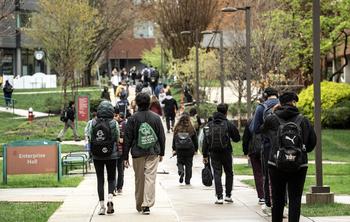The Student Access and Earnings Classification recognizes institutions that foster opportunities for student success.
The Carnegie Foundation and American Council on Education (ACE) announced Thursday that George Mason University was named to the highest tier of its list of Opportunity Colleges and Universities: Higher Access, Higher Earnings, in recognition of the university’s commitment to accessibility, return on investment, and upward mobility.

Carnegie said universities earning this distinction “are higher access, higher earnings institutions that can serve as a model for fostering student success,” according to information from the foundation.
“This ranking from Carnegie and ACE reaffirms George Mason’s commitment to providing access to a high-quality education to all students who are academically prepared for the challenges of an R1 institution,” said George Mason President Gregory Washington. “It reflects our values, our student success rate, and our commitment to graduating students who are prepared to enter the evolving workforce in the commonwealth and beyond.”
The designation is composed of two parts. The access portion refers to Pell Grant recipients and undergraduate students from underrepresented racial and ethnic groups. In fall 2024, 24% of George Mason undergraduate students were first-generation, and 28% were eligible for federal Pell grants, which is greater than the state average. The fall 2024 incoming class also boasted record enrollment for African American, Hispanic, and international students.
George Mason does not use race-based admissions and admits nearly 90% of applicants. The university’s graduation rate exceeds national graduation rates regardless of race, ethnicity, or wealth status. The university’s ADVANCE partnership with Northern Virginia Community College creates successful transfer pathways for students and reduces or eliminates credit loss in the transfer process, saving students time and money.
The earnings portion of the ranking reflects how much graduates earn compared to their peers in the job market. The methodology for this ranking involves Carnegie’s “calculated comparison values,” which are based on the locations served by the institution, using U.S. census data, Carnegie said. A value of 1 indicates that an institution’s data exactly matches the comparison value. Values greater than 1 therefore show that the institution’s data is higher than the comparison value.
Institutions like George Mason that meet the Opportunity Colleges and Universities criteria (Higher Access, Higher Earnings) have an access ratio at or above 1 and earnings ratio at or higher than 1.5, for baccalaureate and higher institutions.
With an access score of 1.2 and an earnings score of 1.64, George Mason is the only public doctoral university in Virginia to achieve the designation. Marymount, a private doctoral university, also received the designation.
As an institution that has been named the top university in Virginia for value and upward mobility by The Wall Street Journal and U.S. News and World Report, George Mason is a catalyst for student success. U.S. News also named George Mason the top school in Virginia for internships reflecting its commitment to developing the talent needed for today’s dynamic workforce.
George Mason graduates earn among the highest starting salaries of graduates from Virginia public universities, on average about $8,000 more. According to a survey of 2024 George Mason graduates, 85% reported a positive career outcome within six months of graduation. According to the State Council of Higher Education for Virginia, 73% of in-state George Mason graduates launch their careers in Virginia, as do 29% of out-of-state George Mason graduates. That out-of-state figure is 45% higher than the state average of 20%.
In the 2025 classifications, 479 institutions have been identified as Opportunity Colleges and Universities, which is about 16% of all classified institutions.
In addition, Carnegie also named George Mason a Mixed Undergraduate/Graduate-Doctorate Large institution, as part of its revamped institutional classifications. This classification includes 107 institutions, or 3% of U.S. colleges and universities in the institutional classification.
The “Mixed” portion recognizes the breadth of degrees George Mason offers, with fewer than 50% awarded in any one category. The “Undergraduate/Graduate” portion requires what Carnegie calls “a sufficient focus on the doctorate,” and the “Large” designation is for schools with at least 20,000 students.
George Mason is one of 107 schools nationwide to earn this designation, representing 3% of U.S. colleges and universities in this institutional classification.
The Carnegie Classifications are updated every three years, with the next scheduled for spring 2028. More information is available here.
Related News
- October 17, 2025
- September 23, 2025
- April 24, 2025
- April 8, 2025
- January 21, 2025
